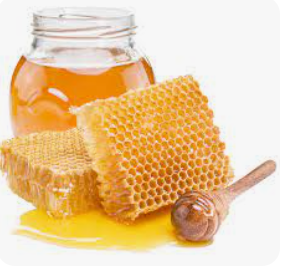By Dr. Cathy Rosenbaum, Holistic Clinical Pharmacist, Certified Fitness Nutrition Coach, CEO Rx Integrative Solutions
NUTRITIONAL VALUE
Honey is a carbohydrate that contains 30% glucose and 40% fructose, both of which when broken down by the body may cause spikes in blood sugar levels. The glycemic index = 58 for pure honey (moderate glycemic index food). For perspective, low glycemic index foods have a GI ≤ 55, moderate glycemic index foods have a GI = 56-69.
The type of flowers that bees pollinate to make the honey determine its taste, color, antioxidant, and vitamin contents. One tablespoonful of honey contains ~64 calories.
TYPES
- Raw honey straight from the hive (available as filtered or unfiltered forms)
- Regular honey (pasteurized, with added sugars)
- Pure honey (pasteurized, no added sugar/ingredients)
- Manuka honey (from the manuka bush)
- Forest honey (from bees fed on tree honeydew instead of flower nectar)
- Acacia honey (from bees fed on flowers of black locust tree)
- Organic honey (available as raw or regular forms)
- Medical grade honey (topical therapeutic)
CONSTITUENTS
Raw honey contains water, bee pollen (26 amino acids), bee propolis (resin, oil and wax, pollen, amino acids, sugars, aromatic compounds), antioxidants (flavonoids), enzymes (diastase, invertase, glucose oxidase), minerals (calcium, copper, iron, magnesium, manganese, phosphorus, potassium zinc), and vitamins (pantothenic acid, niacin, riboflavin, vitamin C, vitamin E).
Raw honey may contain a few more antioxidants and enzymes than pasteurized honey. Pasteurization is necessary to kill any yeast, but may reduce raw honey’s antibacterial action, wound healing benefits, antioxidant value, and anti-inflammatory effects.
It is best not to microwave raw honey or put it directly in boiling water to dissolve crystals that form over time as this may destroy some of its nutrient value.
MEDICINAL EFFECTS
UPPER RESPIRATORY INFECTIONS (URIs)
Honey may be a good natural alternative for treating upper respiratory tract infections (Abuelgasim 2020). In this review of 14 studies mostly in children and a few adults with URIs, authors concluded raw honey used to coat the throat was superior to usual care (e.g., dextromethorphan) for improving cough severity, cough frequency, or both.
WOUND HEALING
Honey has a low pH level (acidic) that may kill harmful bacteria in wounds. As seen in vitro studies, topical therapeutic (medical grade) honey may inhibit bacterial growth due to its high sugar content, acid pH, hydrogen peroxide production within the wound to aid in debridement, and moisture.
Subrahmanyam (1998) described a prospective randomized clinical and histological study of burn wound healing in two groups of 25 patients assigned to either topical therapeutic honey or topical silver sulfadiazine. In the honey treated group, 84% of patients demonstrated epithelialization by day seven, and all of them demonstrated satisfactory wound healing by day twenty-one. In the silver sulfadiazine treated group, epithelialization was present by day seven for 72% of patients and by day 21 for 84% of patients.
Regarding histological evidence of wound healing, 80% of patients treated with honey showed wound improvement by day seven compared to 52% of silver sulfadiazine treated patients by day seven. These outcomes continued to improve for both groups up to 21 days of treatment.
Medical grade honey should only be applied with the advice and consent of a physician. Bacterial susceptibility varies based on length of topical exposure to therapeutic honey. It is prudent to closely monitor the use of therapeutic honey in patients with all wounds, especially diabetic ulcers due to risk of infection. Before therapeutic honey is used on an open wound, the wound should be swabbed for bacteria culture and sensitivity to honey determined before treatment if necessary.
Not all food grade honey is sterile, and Clostridium botulinum can survive in honey, thereby causing a risk of wound botulism when applied to the wound. Food-grade honey should not be used for wound healing. Clinicians should consult the honey manufacturer to find out more about the product before applying honey to an open wound.
SAFETY
Using/taking honey by any route of administration is contraindicated in individuals allergic to honey or pollens contained therein, and in children less than one year of age (Abell 2020). Individuals with diabetes mellitus should monitor oral honey consumption and its effect on their blood sugar levels.
BOTTOM LINE
Honey is an alternative to table sugar or agave syrup, artificial sugar substitutes, or Stevia for sweetening effects, nutritional value, and potential medicinal use. Please consult with your physician for an accurate diagnosis and directions on how best to use honey for any medicinal or therapeutic purposes.
REFERENCES
Abell. Honey for upper respiratory tract infections. Pharmacy Today November 2020.
Abuelgasim. BMJ Evidence-Based Medicine August 18, 2020.
Almassandi. The antibacterial activities of honey. Saudi J Biol Sci 2021.
Boukraa L. Honey use in burn management: potentials and limitations. Forsch Komplementmed 2010;17:74-80.
Cooper R, Wigley P, Burton NF. Susceptibility of multi-resistant strains of Burkholderia cepacia to honey. Lett Appl Microbiol 2000;31:20-24.
Jull. Honey as a topical treatment for wounds. Cochrane Database Syst Review 2015.
Maric. A comprehensive study of parameters correlated with honey health benefits. RSC Adv 2021.
Niaz. Health benefits of manuka honey as an essential constituent for tissue regeneration. Curr Drug Metab 2017.
Olaitan PB. Honey: a reservoir for microorganisms and an inhibitory agent for microbes. African Health Sci 2007;7:159-165.
Pimentel. Stingless bee honey. An overview of health benefits and main market challenges. J Food Biochem 2022.
Sinha. Benefits of manuka honey in the management of infectious disease. Recent advances and prospects. Mini Rev Med Chem 2023.
Subrahmanyam M. A prospective randomized clinical and histological study of superficial burn wound healing with honey and silver sulfadiazine. Urns 1998;24:157-161.
